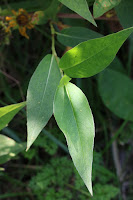If you are looking to be healthier in 2018, why not strive to get outside and move on one of your neighborhood trails? Getting out in nature is good for your health, and free. It also provides an opportunity to get to know your neighbors, be they of the human, botanical, or ornithological variety.
 Volunteering is another satisfying goal that is easy to achieve. You can help clean up various areas around town, help remove invasive species from Bur Oak Land Trust properties, or just commit to picking up trash along the street every couple of weeks. It doesn't take a lot of time to make a difference.
Volunteering is another satisfying goal that is easy to achieve. You can help clean up various areas around town, help remove invasive species from Bur Oak Land Trust properties, or just commit to picking up trash along the street every couple of weeks. It doesn't take a lot of time to make a difference.Reducing waste is an admirable goal, and also easy to achieve. Try to reduce dependence on single-use, disposable plastics like grocery bags, straws, and plastic utensils. How silly to extract oil from the depths of the earth and process it until it eventually becomes a single straw, used once and thrown away? Just a little planning can reduce some of the waste that inevitably accompanies our basic existence: carry reusable grocery bags and mesh produce bags in your car so they will always be handy when shopping; skip the straw or invest in reusable plastic or stainless steel straws and utensils.
New hobbies are always fun, and great for keeping your mind sharp. Take up photography, drawing, or commit to learning to recognize a dozen new birds or plants that you encounter outside throughout the year (that's just one a month!). Keep a journal, or write poems using what is outside your window as inspiration.
If you are politically inclined, you can promote bipartisan legislation among both friends and family as well as your state and local representatives to helps places like the Greenway (without wading too far into the divisive mess of current national politics). Support strengthening and expanding the bottle bill, to keep trash off of our streets (and out of the Greenway). Encourage lawmakers to Fund the Trust, to help pay for clean water and wildlife habitat that will benefit all Iowans.
Even if you are not a gardener, you can easily commit to planting a few native flowers in your garden this spring or summer to provide habitat for our pollinator friends. Small things go a long way toward improving your little corner of the world, and what better time than now to start making your plans?
























































